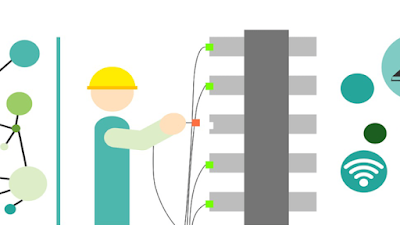Computer Networking
 |
| computer-networking |
Computer Networking in English
A computer network is a digital telecommunications network that allows nodes to share resources.
In computer networks, network computing devices exchange data with each other using data links. Cable media or wireless media are used for connection between nodes.
Computer networks, hardware, and software combinations are made.
What is Computer Network
Computer networking is a group of computers and other devices for the purpose of communication, which is connected to wired (LAN), wireless or internet.
Network Devices can have switches and routers, including many types of devices such as Printer, Scanner, Server.
To exchange information in the network, protocols, and algorithms are used.
Each endpoint of the network (sometimes called a host) is a unique identifier, often an IP address or a Media Access Control (MAC) address.
It is used to indicate the transmission or destination of transmission. An endpoint can include servers, personal computers, phones and many types of network hardware.
Wired and Wireless Technology:
Networks can use a mix of wired and wireless technologies. Network devices do communications via wired or wireless transmission medium.
Wired networks can include optical fiber, coaxial cable or copper wires. Wireless networks have data communication between all nodes via a wireless medium. This medium can be broadcast radio, cellular radio, microwave, and satellite.
Networks can be private or public. The user needs a permit to access the private network. Generally, this is given manually by a network administrator or given access to the user by a password or other credentials. There is no access reorder for the internet, such as the public network.
A computer network is a communication channel through which we can share our data. Therefore it is also called a data network.
Criteria for the Data Communications Network:
Major Criteria which should meet the Data Communications Network: Performance, Reliability, Recovery, and Security
i) Performance:
Performance is defined by the rate of error-free transfer of data. This response is measured by time.
Response Time
Where is the Response Time at the time of sending a request from an end to the network and the time of its response to the other end?Factors affecting Response Time are:
Number of Users: If there are more users on a network then networks can be slow.
Transmission speed: Data transmission speed bits are measured in per second (bps).
Media type: The type of physical connection used to connect nodes.
Hardware type: Fasts like slow computer or Pentium
Software program: How good are the network operating system (NOS).
ii) Consistency:
Users always want less time of response, because if it is taking more than 30 seconds to give print command and print, there may be some problem in the network.
Accuracy of data determines how reliable the network is!
iii) Reliability:
The reliability of the network is that how often a network is usable. MTBF -Mean Time Between Failures (The Time Between Failure) is an excerpt of an average time in which a component works between relative failures. Generally, information is given by the manufacturer.The failure of a network is due to the failure of hardware, media-or network operating systems.
iv) Recovery:
After the failure of the recovery network, the network's ability to go back to the set level of operation.
v) Security:
Security is protected from the unauthorized use of hardware, software, and data. Computers are given password protection for access. Along with this, antivirus and firewall are also used.

No comments:
Post a Comment